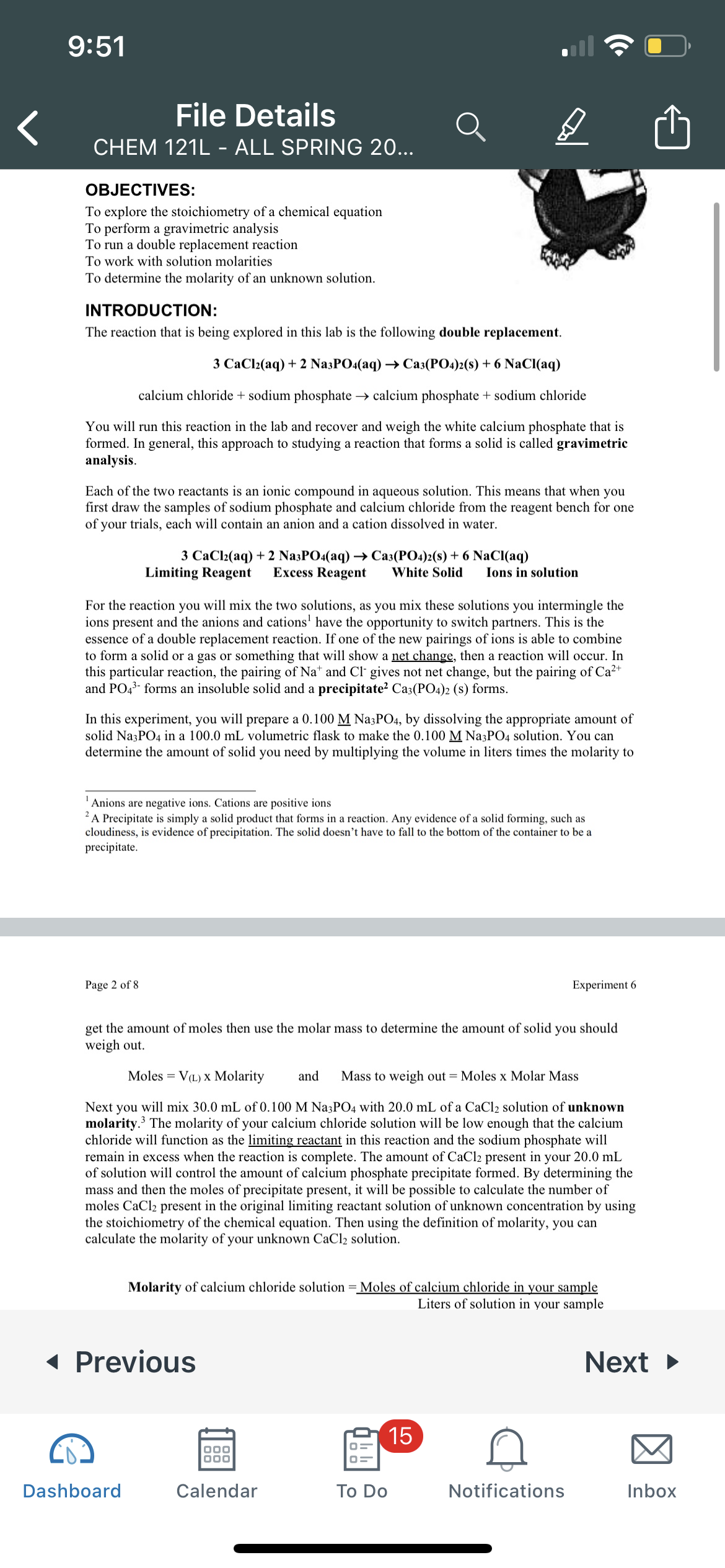Chemistry
10th Edition
ISBN:9781305957404
Author:Steven S. Zumdahl, Susan A. Zumdahl, Donald J. DeCoste
Publisher:Steven S. Zumdahl, Susan A. Zumdahl, Donald J. DeCoste
Chapter18: Electrochemistry
Section: Chapter Questions
Problem 9RQ: What characterizes an electrolytic cell? What is an ampere? When the current applied to an...
Related questions
Question
What is the role of sodium and chloride ions in this experiment

Transcribed Image Text:9:51
File Details
CHEM 121L - ALL SPRING 20...
OBJECTIVES:
To explore the stoichiometry of a chemical equation
To perform a gravimetric analysis
To run a double replacement reaction
To work with solution molarities
To determine the molarity of an unknown solution.
INTRODUCTION:
The reaction that is being explored in this lab is the following double replacement.
3 СаCl(aq) + 2 NasPO4(aq) > Саз(РО4)2(8) + 6 NaC{aq)
calcium chloride + sodium phosphate → calcium phosphate + sodium chloride
You will run this reaction in the lab and recover and weigh the white calcium phosphate that is
formed. In general, this approach to studying a reaction that forms a solid is called gravimetric
analysis.
Each of the two reactants is an ionic compound in aqueous solution. This means that when you
first draw the samples of sodium phosphate and calcium chloride from the reagent bench for one
of your trials, each will contain an anion and a cation dissolved in water.
3 CaCl2(aq) + 2 Na3PO4(aq) → Ca3(PO4)2(s) + 6 NaCI(aq)
Limiting Reagent
Excess Reagent
White Solid
Ions in solution
For the reaction you will mix the two solutions, as you mix these solutions you intermingle the
ions present and the anions and cations' have the opportunity to switch partners. This is the
essence of a double replacement reaction. If one of the new pairings of ions is able to combine
to form a solid or a gas or something that will show a net change, then a reaction will occur. In
this particular reaction, the pairing of Nat and Cl gives not net change, but the pairing of Ca2+
and PO4 forms an insoluble solid and a precipitate? Ca3(PO4)2 (s) forms.
In this experiment, you will prepare a 0.100 M Na3PO4, by dissolving the appropriate amount of
solid NazPO4 in a 100.0 mL volumetric flask to make the 0.100 M Na3PO4 solution. You can
determine the amount of solid you need by multiplying the volume in liters times the molarity to
Anions are negative ions. Cations are positive ions
A Precipitate is simply a solid product that forms in a reaction. Any evidence of a solid forming, such as
cloudiness, is evidence of precipitation. The solid doesn't have to fall to the bottom of the container to be a
precipitate.
Page 2 of 8
Experiment 6
get the amount of moles then use the molar mass to determine the amount of solid you should
weigh out.
Moles = V(L) X Molarity
and
Mass to weigh out = Moles x Molar Mass
Next you will mix 30.0 mL of 0.100 M Na3PO4 with 20.0 mL of a CaCl2 solution of unknown
molarity. The molarity of your calcium chloride solution will be low enough that the calcium
chloride will function as the limiting reactant in this reaction and the sodium phosphate will
remain in excess when the reaction is complete. The amount of CaCl2 present in your 20.0 mL
of solution will control the amount of calcium phosphate precipitate formed. By determining the
mass and then the moles of precipitate present, it will be possible to calculate the number of
moles CaCl2 present in the original limiting reactant solution of unknown concentration by using
the stoichiometry of the chemical equation. Then using the definition of molarity, you can
calculate the molarity of your unknown CaCl2 solution.
Molarity of calcium chloride solution = Moles of calcium chloride in your sample
Liters of solution in your sample
( Previous
Next >
15
Dashboard
Calendar
Тo Do
Notifications
Inbox
Expert Solution
This question has been solved!
Explore an expertly crafted, step-by-step solution for a thorough understanding of key concepts.
This is a popular solution!
Trending now
This is a popular solution!
Step by step
Solved in 2 steps

Knowledge Booster
Learn more about
Need a deep-dive on the concept behind this application? Look no further. Learn more about this topic, chemistry and related others by exploring similar questions and additional content below.Recommended textbooks for you

Chemistry
Chemistry
ISBN:
9781305957404
Author:
Steven S. Zumdahl, Susan A. Zumdahl, Donald J. DeCoste
Publisher:
Cengage Learning

Chemistry: An Atoms First Approach
Chemistry
ISBN:
9781305079243
Author:
Steven S. Zumdahl, Susan A. Zumdahl
Publisher:
Cengage Learning


Chemistry
Chemistry
ISBN:
9781305957404
Author:
Steven S. Zumdahl, Susan A. Zumdahl, Donald J. DeCoste
Publisher:
Cengage Learning

Chemistry: An Atoms First Approach
Chemistry
ISBN:
9781305079243
Author:
Steven S. Zumdahl, Susan A. Zumdahl
Publisher:
Cengage Learning


Chemistry for Engineering Students
Chemistry
ISBN:
9781337398909
Author:
Lawrence S. Brown, Tom Holme
Publisher:
Cengage Learning

Chemistry & Chemical Reactivity
Chemistry
ISBN:
9781337399074
Author:
John C. Kotz, Paul M. Treichel, John Townsend, David Treichel
Publisher:
Cengage Learning

Chemistry & Chemical Reactivity
Chemistry
ISBN:
9781133949640
Author:
John C. Kotz, Paul M. Treichel, John Townsend, David Treichel
Publisher:
Cengage Learning